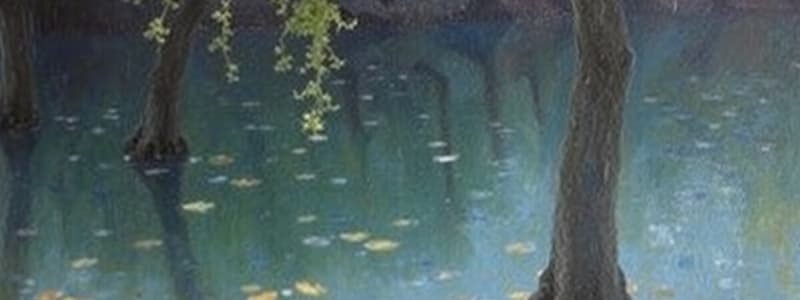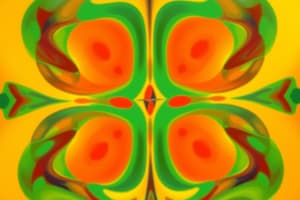Podcast
Questions and Answers
What is the concept of 'geons' in Biederman's recognition by components theory?
What is the concept of 'geons' in Biederman's recognition by components theory?
- Patterns formed by multiple objects
- Basic geometric shapes used in object recognition (correct)
- Colors that are recognized in isolation
- Complex designs that confuse viewers
How does top-down processing influence perception?
How does top-down processing influence perception?
- It relies solely on sensory input.
- It is influenced by past experiences and expectations. (correct)
- It focuses on details rather than context.
- It selects information based on perceptual features only.
What role does abstraction play in perception?
What role does abstraction play in perception?
- It requires processing of every detail of an object.
- It allows for faster and more efficient encoding of information. (correct)
- It eliminates the need for any contextual influence.
- It focuses on storing exact representations of objects.
What phenomenon occurs when a moving rectangle causes the perception that a bright spot inside it is moving in the opposite direction?
What phenomenon occurs when a moving rectangle causes the perception that a bright spot inside it is moving in the opposite direction?
What is the primary role of shape in the recognition of objects?
What is the primary role of shape in the recognition of objects?
What are perceptual constancies concerned with?
What are perceptual constancies concerned with?
What is color constancy primarily about?
What is color constancy primarily about?
Which type of visual cortex cell responds to bar or edge stimuli in particular orientations without needing a specific position?
Which type of visual cortex cell responds to bar or edge stimuli in particular orientations without needing a specific position?
What cognitive process involves forming a global understanding of a scene before identifying individual objects?
What cognitive process involves forming a global understanding of a scene before identifying individual objects?
Why does brightness constancy occur?
Why does brightness constancy occur?
What effect occurs when a static bright spot in a dark place is perceived to move due to the absence of reference points?
What effect occurs when a static bright spot in a dark place is perceived to move due to the absence of reference points?
Which aspect best describes the information processing of the brain regarding the distal stimulus?
Which aspect best describes the information processing of the brain regarding the distal stimulus?
What role does the context of a scene play in object recognition?
What role does the context of a scene play in object recognition?
In the context of visual perception, what is a primary reason for the ability to read jumbled letters in words?
In the context of visual perception, what is a primary reason for the ability to read jumbled letters in words?
What is a characteristic requirement of hypercomplex cells in visual processing?
What is a characteristic requirement of hypercomplex cells in visual processing?
What effect describes the visual perception of motion when static images are presented in quick succession?
What effect describes the visual perception of motion when static images are presented in quick succession?
What does mimetism refer to in perception?
What does mimetism refer to in perception?
Which concept refers to the recognition of phenomena experienced by our senses at the cerebral level?
Which concept refers to the recognition of phenomena experienced by our senses at the cerebral level?
How does the Muller-Lyer illusion demonstrate perception?
How does the Muller-Lyer illusion demonstrate perception?
What is one of the primary functions of attention in perception?
What is one of the primary functions of attention in perception?
Which of the following statements best describes perceptual constancies?
Which of the following statements best describes perceptual constancies?
Which term refers to the physical stimulus as it exists in reality?
Which term refers to the physical stimulus as it exists in reality?
What does the term 'recognition' refer to in the context of perception?
What does the term 'recognition' refer to in the context of perception?
The term 'localization' in perception involves which of the following?
The term 'localization' in perception involves which of the following?
Flashcards
Color Constancy
Color Constancy
The ability of the visual system to perceive the color of an object despite changes in the light source. For example, a red apple appears red under both sunlight and a lamplight.
Brightness Constancy
Brightness Constancy
The ability of the visual system to perceive the brightness of an object despite changes in the overall intensity of the light source. For example, a white paper appears similarly white under a dim lamp and under bright sunlight.
Recognition by Components Theory (Biederman 1987)
Recognition by Components Theory (Biederman 1987)
The process of recognizing objects by identifying their basic geometric components (GEONS) and their spatial relationships. This theory suggests that we can recognize objects even if they are partially obscured or in novel viewpoints. Example: a mug can be recognized even if it's tilted, due to the recognition of its GEONs (cylinder, handle).
Abstraction
Abstraction
Signup and view all the flashcards
Top-Down Processing
Top-Down Processing
Signup and view all the flashcards
Bottom-Up Processing
Bottom-Up Processing
Signup and view all the flashcards
Indirect Perception
Indirect Perception
Signup and view all the flashcards
Perceptual Constancies
Perceptual Constancies
Signup and view all the flashcards
Mimetism
Mimetism
Signup and view all the flashcards
Anomalous Figures
Anomalous Figures
Signup and view all the flashcards
Perception
Perception
Signup and view all the flashcards
Localization
Localization
Signup and view all the flashcards
Recognition
Recognition
Signup and view all the flashcards
Perceptual Constancy
Perceptual Constancy
Signup and view all the flashcards
Attention
Attention
Signup and view all the flashcards
Induced Motion
Induced Motion
Signup and view all the flashcards
Stroboscopic motion
Stroboscopic motion
Signup and view all the flashcards
Autokinetic Motion
Autokinetic Motion
Signup and view all the flashcards
Global-to-Local processing for object recognition
Global-to-Local processing for object recognition
Signup and view all the flashcards
Object recognition through shape analysis
Object recognition through shape analysis
Signup and view all the flashcards
Feature detectors in the visual cortex
Feature detectors in the visual cortex
Signup and view all the flashcards
How feature detectors work for natural objects
How feature detectors work for natural objects
Signup and view all the flashcards
Study Notes
Course of Experimental Psychology: Perception
- Course offered by Università Cattolica del Sacro Cuore in Milan
- Instructor: Claudia Repetto
Table of Contents (TOC)
- Perception: definition and functions
- Localization: separation of objects
- Localization: perceiving distance
- Localization: perceiving motion
- Recognition: global-to-local processing
- Recognition: identifying objects
- Perceptual constancies
How Raw Sensations are Translated into Perception
- Images shown: a drawing of a skull and the words "I LOVE PARIS IN THE SPRINGTIME"
- Raw sensations are processed to form a perception.
Physical Reality and Phenomenal Reality
- Mimetism: the absence of a phenomenal object when a physical object is present
- Anomalous figures: a phenomenon where what's absent physically is perceived
- Optical illusions: discrepancies between physical and perceived objects
Absence of Phenomenal Object: Mimetism
- Examples of images shown: a circle divided into sections, a triangle
- These show how our perception can be different from physical reality.
Absence of Physical Object: Anomalous Figures
- Kanizsa's triangle is an example.
- The figure is perceived even if not physically present
Optical Illusions
- Muller-Lyer illusion: lines appear different lengths even though they are the same length.
Psychophysical Chain
- Distal Stimulus: the physical stimulus in reality. Example: an apple
- Proximal Stimulus: the receptor's (like eyes or ears) response to the distal stimulus. Example: the image of the apple on the retina
- Percept: the result at the cerebral level, the recognition of the phenomena. Example: perceiving the object and identifying it as an apple.
Five Functions of Perception
- Attention: deciding which information to process
- Localization: determining where an object is
- Recognition: knowing what an object is
- Abstraction: extracting key features of an object
- Perceptual constancies: maintaining unchanged features of an object even when it appears different.
Localization: Perceiving Distance
- The retina is two-dimensional, but we perceive a three-dimensional world.
- Depth cues are used to determine distance.
Binocular Cues
- Binocular disparity: the difference between two retinal images allows perception of distance.
Monocular Cues
- Relative size: smaller objects seem further away
- Interposition: one object blocking our view of a second suggests it is closer
- Relative height: objects near the horizon seem further away
- Perspective: parallel lines seem to converge as they recede
- Shading and shadows: reveal object shapes, distance of objects relative to each other, and position of the light source
- Motion parallax: the relative motion of objects depending on their distance from us.
Localization: Perceiving Motion
- An object's motion is perceived when the retinal image moves relating to a background.
- The image on the retina enlarges as an object moves towards us.
- However, our perception isn't a constant flow of motion
See the Following Effects...
- Induced motion: a stationary object appears to move when surrounding objects move
- Stroboscopic motion: rapid succession of stationary images creates the illusion of continuous motion. Example: a flipbook
- Autokinetic motion: a stationary object appears to move in a dark setting
Recognition: Global-to-Local Processing
- The brain processes the whole scene, recognizing objects by using this global information .
- Also, it uses details of specific objects
Recognition: Determining What an Object Is
- Visual processing, starting with input from the retina, uses both bottom-up and top-down processes for identification
- Bottom-up processing: identifying shapes by simple cells, complex cells, and hyper complex cells
- Top-down processing: knowledge, context, and previous experience influence object recognition
Bottom-Up Processes (Recognition)
- Biederman's recognition-by-components theory:
- Objects break down into geons (geometric ions) like cylinders or cones. This gives us a basic understanding of the object's shape
Top-Down Processes (Recognition)
- Perception is guided by previous experiences, context of information, expectations, and motivations.
Abstraction
- We don't need to process all of an object's details to identify it
- Abstraction helps to extract important features to do whatever task is required
Perceptual Constancies
- The brain adapts to compensate for incomplete or inconsistent information.
- Color Constancy: perceiving object color despite changes in illumination . Brightness constancy: perceiving object lightness despite changes in light source intensity
- Shape constancy: perceiving the same shape despite changes in the retinal image
- Size constancy: perceiving the same size despite changes in retinal image size.
- Size constancy depends on depth cues. .
Studying That Suits You
Use AI to generate personalized quizzes and flashcards to suit your learning preferences.




